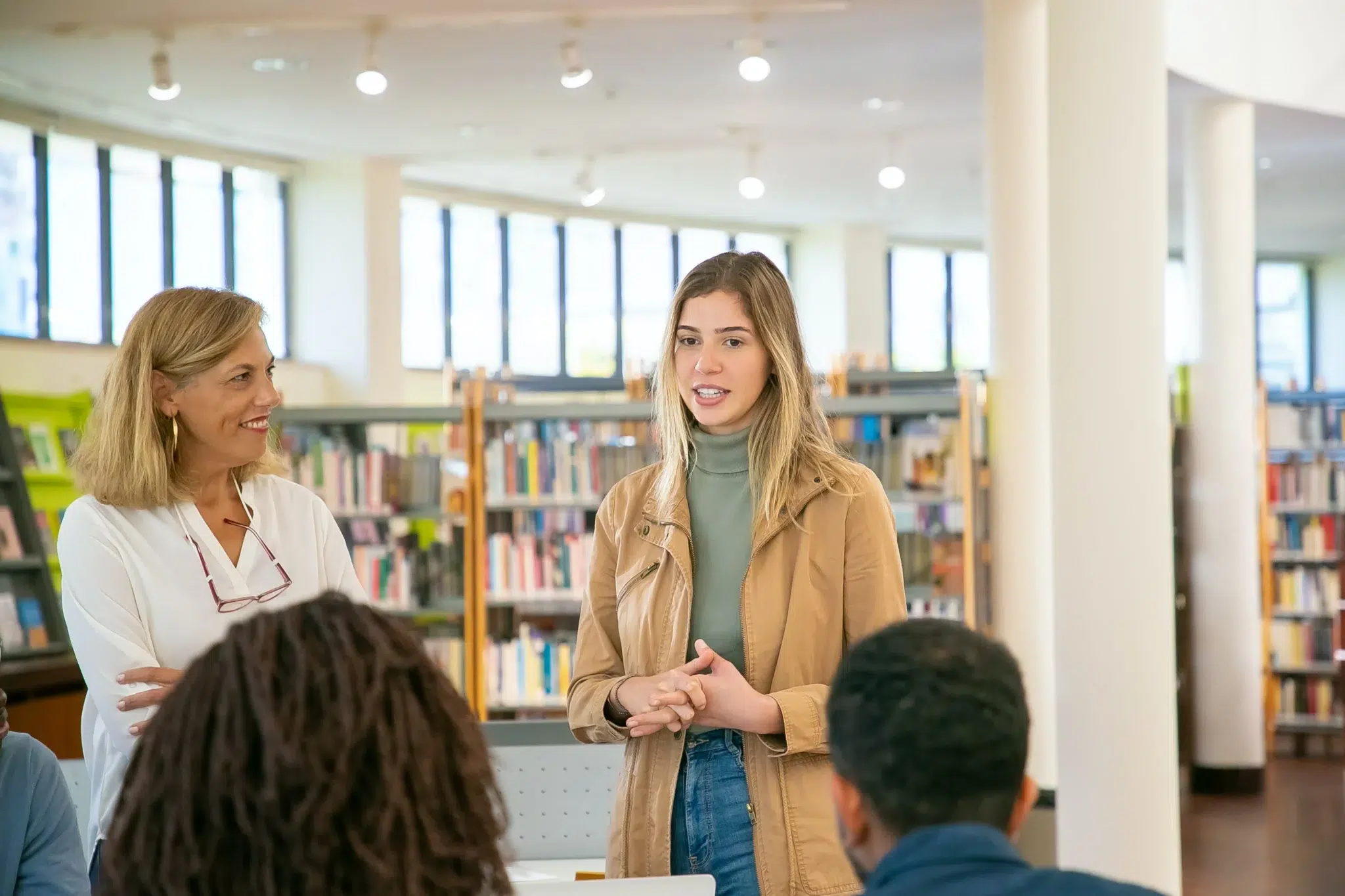Auditory Learning Strategy
Engagement Techniques
Auditory learning involves listening to information rather than reading it. Learners can use techniques like reciting information aloud or participating in group discussions to enhance this strategy.
Advantages and Disadvantages
-
Pros:
-
It is effective for individuals who grasp information better through hearing.
-
Enhances listening skills and memory retention.
-
-
Cons:
-
It may be challenging for visual learners.
-
Requires a quiet environment for optimal learning.
-
Implementation Tips
Individuals can benefit from audio recordings of lectures, podcasts, or verbal explanations when implementing auditory learning strategies. Repeating information verbally can reinforce understanding.
Real-life Application
In a classroom setting, students can engage in activities like listening comprehension exercises or oral presentations to improve their auditory learning skills. Teachers can incorporate audiobooks or podcasts to cater to auditory learners‘ learning styles.
Kinesthetic Learning Approach
Active Participation
Kinesthetic learning involves active participation in the learning process, such as hands-on activities and experiments. Students learn best by doing rather than just listening or watching.
They engage in physical movements while learning, which helps individuals retain information more effectively. This approach is beneficial for learners who struggle with traditional teaching methods.
Practical Applications
-
Pros:
-
Enhances memory retention
-
Encourages creativity and critical thinking
-
Suitable for learners with ADHD or hyperactivity
-
-
Cons:
-
Requires specific resources and space
-
This is not always feasible in a traditional classroom setting
-
Experiential Learning
Experiential learning, a key component of kinesthetic learning, allows students to apply theoretical knowledge in real-world scenarios. This hands-on approach bridges the gap between theory and practice.
Overview of Learning Styles
Visual Learning
Visual learning involves using images, diagrams, and charts to understand information better. This method helps learners retain data more effectively by seeing it visually.
Learners prefer visual learning often benefit from color-coded notes, mind maps, and flashcards. This style aids in enhancing memory retention and improving comprehension.
Auditory Learning
Auditory learners grasp information best through listening and speaking. They excel in environments where information is presented through lectures, discussions, or audiobooks, catering to their learning style.
Reading aloud, participating in group discussions, and using mnemonics benefit auditory learners. These techniques help in reinforcing concepts and fostering better understanding.
Logical Learning
Logical learners with a logical learning style rely on reasoning and systems to comprehend new information. They excel in activities that involve problem-solving, patterns, and critical thinking.
For logical learners, creating outlines, engaging in debates, and solving complex puzzles can strengthen analytical skills and enhance cognitive abilities.
Four Learner Types in Education
Visual Learners
Visual learners prefer using images, diagrams, and spatial understanding to learn. They benefit from visual aids like charts and graphs.
Visual learners often excel in subjects like art, design, and geography due to their ability to visualize information effectively.
Auditory Learners
Auditory learners rely on listening and speaking to understand new concepts. They grasp information best through lectures, discussions, and audiobooks.
These learners thrive in environments where they can actively participate in debates or presentations.
Kinesthetic Learners
Kinesthetic learners learn best through hands-on experiences and physical activities. They prefer learning by doing rather than passively listening.
These learners excel in subjects like sports, science experiments, and vocational training that involve practical application.
Reading/Writing Learners
Reading/writing learners prefer consuming information through written text. They excel in reading books, writing essays, and taking notes during lectures.
These learners benefit from creating detailed study guides and engaging in extensive reading assignments.
The VARK Learning Model
Visual Learners
Visual learners prefer to learn through images, graphs, and other visual aids. They excel in environments with diagrams and videos.
Auditory Learners
Auditory learners thrive when information is presented through sound. They benefit from lectures, discussions, and audiobooks.
Reading/Writing Learners
Reading/writing learners excel when engaging with written materials like textbooks, articles, and note-taking.
Kinesthetic Learners
Kinesthetic learners learn best through hands-on experiences and activities. They prefer to engage physically with the subject matter.
Each learning style has its strengths and weaknesses. For example, visual learners may struggle with purely auditory teaching methods, while auditory learners might find focusing in visually stimulating environments challenging.
Pros and Cons of the VARK Learning Model:
-
Pros:
-
Tailored approach to individual learning preferences
-
Enhances understanding and retention of information
-
-
Cons:
-
May oversimplify complex learning processes
-
Can limit exposure to different learning styles
-
Exploring Learning Styles
Visual Learners
Visual learners prefer to learn through images, graphs, and other visual aids. They often benefit from color-coded notes and diagrams.
They tend to remember information better when it is presented in a visual format. Examples include watching educational videos and using flashcards.
Auditory Learners
Auditory learners excel at learning through listening. They retain information best through lectures, discussions, and audiobooks.
They may struggle with written instructions but thrive in group discussions and oral presentations.
Kinesthetic Learners
Kinesthetic learners learn best through hands-on activities and experiences. They prefer to engage physically with the material.
They enjoy experiments, role-playing, and interactive simulations to grasp concepts effectively.
Reading/Writing Learners
Reading/writing learners prefer traditional methods like reading textbooks and taking detailed notes. They excel in written assignments and essay-based assessments.
They benefit from summarizing information in their own words and creating study guides for revision.
Visual Learning Method
Benefits
The visual learning method enhances understanding through images and diagrams, aiding in better retention of information. It helps learners process complex data by breaking it into visual elements for easier comprehension.
Challenges
Learners might struggle with this method if they have difficulty interpreting visual cues or have visual impairments.
Examples
-
Mind maps: Organize information visually to establish connections and relationships between concepts.
-
Infographics: Present data and information in a visually appealing format for quick understanding.
Reading/Writing Learning Preference
Pros and Cons
Pros:
-
Effective for memorization
-
Suitable for academic settings
Cons:
-
Less interactive
-
This may lead to passive learning
Regarding the Reading/Writing Learning Preference, individuals who prefer this style excel in tasks involving written materials. They often benefit from taking notes, reading textbooks, and writing essays to enhance their understanding of a subject. This learning strategy is commonly used in traditional educational settings, such as schools and universities.
Strategies for Reading/Writing Learners
For Reading/Writing Learners, engaging material is essential. Taking detailed essential notes while reading, summarizing key points in writing, and creating outlines can significantly boost comprehension. Practising active reading techniques like asking questions about the text and making connections to personal experiences can deepen understanding.
Implementing Effective Techniques
To enhance the effectiveness of this learning preference, individuals can utilize tools like flashcards, study guides, and mnemonic devices to aid in retention. Breaking down complex information into smaller chunks and organizing it in a structured format can facilitate easier comprehension and recall.
Classroom Strategies for Learning Styles
Visual Learners
Visual learners benefit from diagrams and charts. Teachers can use visual aids like slideshows to enhance learning.
Visual learners may struggle with verbal instructions, so teachers should provide written instructions and visual cues.
Auditory Learners
Auditory learners excel with verbal explanations. Teachers can incorporate discussions and audio recordings to aid learning. Teachers should encourage group discussions and incorporate lectures into lessons.
Kinesthetic Learners
Kinesthetic learners learn best through hands-on activities. Teachers can include experiments and role-playing exercises in the classroom.
Providing opportunities for movement and physical engagement can enhance learning for kinesthetic learners.
Understanding Learning Style Theory
Visual Learners
Visual learners prefer learning through images, diagrams, and charts. They grasp information better when it is visually presented.
Visual learners benefit from using color-coded notes to organize information effectively.
Auditory Learners
Auditory learners learn best through listening and speaking. They excel in environments with discussions and lectures.
To enhance learning, auditory learners can record lectures or discussions and listen to them later for better retention.
Kinesthetic Learners
Kinesthetic learners learn by doing and experiencing. They understand concepts better through hands-on activities.
For kinesthetic learners, engaging in role-playing exercises can aid in understanding complex topics effectively.
Four Types of Learning Styles
Visual Learners
Visual learners prefer to learn through images, diagrams, and spatial understanding. They benefit from visual aids in lectures and videos that illustrate concepts clearly.
Visual learners excel in subjects like art, design, and geography. They may struggle with purely auditory learning methods or dense text-based materials.
Auditory Learners
Auditory learners thrive on listening and speaking activities. They absorb information best through lectures, group discussions, and podcasts.
Auditory learners enjoy subjects like languages, music, and public speaking. They might find focusing in noisy environments or during silent reading sessions challenging.
Kinesthetic Learners
Kinesthetic learners learn best through hands-on experiences and physical activities. They understand concepts by doing rather than just observing or listening.
Kinesthetic learners perform well in sports, science experiments, and vocational training. They may struggle with traditional classroom settings that lack interactive elements.
Utilizing Learning Styles in Teaching
Visual Learning
Visual learning involves using images, graphs, and charts to aid comprehension. This method benefits students who grasp information better through visual aids.
Students can benefit from visually appealing presentations and diagrams that simplify complex concepts.
Auditory Learning
Auditory learners absorb information effectively through listening. They benefit from lectures, discussions, and audio materials.
Teachers can incorporate podcasts, group discussions, and verbal instructions for auditory learners.
Kinesthetic Learning
Kinesthetic learners learn best through hands-on activities. They excel in experiments, role-playing, and interactive tasks.
Incorporating experiments, simulations, and real-life examples can enhance the learning experience for kinesthetic learners.
Reading/Writing Learning
Reading/writing learners prefer written materials to understand concepts. They thrive on textbooks, articles, and note-taking.
Providing reading assignments, writing exercises, and study guides can help reading/writing learners comprehend information effectively.
Adapting Teaching Methods for Learners
Tailoring Instruction
Tailoring instruction to different learning styles enables educators to effectively reach a diverse group of students. Teachers can ensure that all learners grasp the material by incorporating visual, auditory, kinesthetic, and reading/writing techniques.
Adapting teaching methods involves recognizing individual preferences and adjusting content delivery accordingly. Using diagrams, charts, and videos can enhance comprehension. Auditory learners benefit from lectures, discussions, and audio recordings.
Providing Flexibility
Providing flexibility in assignments and assessments allows students to demonstrate their understanding in various ways. Writing essays, presentations, or hands-on projects cater to different learning preferences.
By encouraging student autonomy, educators empower learners to select methods that align with their strengths. This approach fosters engagement and motivation, leading to improved academic performance.
Incorporating Technology
Integrating technology into lessons offers interactive and engaging learning experiences. Educational apps, online resources, and virtual simulations cater to digital-native students and enhance comprehension through multimedia elements.
Technology also facilitates personalized learning, allowing students to progress at their own pace. Adaptive software adjusts difficulty levels based on individual performance, promoting mastery of concepts.
Practical Applications for Educators
Implementing Diverse Strategies
Educators can enhance learning outcomes by implementing diverse strategies tailored to various learning styles. By incorporating visual aids, hands-on activities, and group discussions, teachers can cater to the needs of auditory, visual, and kinesthetic learners. This approach fosters a more inclusive and engaging learning environment.
Leveraging Technology Tools
Integrating technology tools such as educational apps, interactive whiteboards, and online resources can enrich the learning experience. These tools offer personalized learning opportunities, instant feedback, and real-time student collaboration. Educators can leverage these resources to create dynamic lessons that cater to individual student needs.
Encouraging Active Participation
Encouraging active participation through class discussions, debates, and project-based assessments can boost student engagement and critical thinking skills. By promoting a collaborative learning environment, educators empower students to take ownership of their learning journey. This interactive approach not only enhances retention but also cultivates essential life skills.
Providing Constructive Feedback
Offering constructive feedback that is specific, timely, and actionable is crucial for student growth. Educators should praise achievements and guide for improvement to motivate students towards continuous progress. Constructive feedback fosters a growth mindset and encourages students to embrace challenges as opportunities for learning and development.
Improving Student Engagement Techniques
Active Participation
Encouraging active participation in the learning process boosts student engagement and comprehension. Educators can create a dynamic learning environment by incorporating group discussions, hands-on activities, and interactive presentations.
Fostering an atmosphere where students feel comfortable sharing their thoughts and ideas helps build confidence and enhance critical thinking skills. This approach not only improves academic performance but also promotes collaboration among peers.
Technology Integration
Integrating technology into lessons can significantly enhance student engagement. Educational apps, interactive whiteboards, and online resources provide multimedia experiences catering to diverse learning styles. By leveraging digital tools, educators can make learning more interactive and stimulating.
Implementing virtual field trips or incorporating gamified elements into lessons can make learning more engaging and enjoyable for students. Technology integration makes learning fun and prepares students for the digital world they will navigate in the future.
Tailoring Instruction to Learning Preferences
Visual Learners
Visual learners prefer learning through images and diagrams. They benefit from visual aids like charts, graphs, and videos.
Visual learners can excel in subjects like art, geography, and biology. Using colourful diagrams and visual representations can enhance their understanding.
Auditory Learners
Auditory learners learn best through listening. They thrive in environments with verbal instructions, discussions, and lectures.
For auditory learners, podcasts and audiobooks are practical study tools. They may struggle with silent reading but excel in group discussions.
Kinesthetic Learners
Kinesthetic learners learn by doing. They grasp concepts best through hands-on activities and experiments.
For kinesthetic learners, interactive simulations and practical demonstrations are valuable. They benefit from role-playing exercises and real-world applications.
Improving Student Engagement Techniques
Active Participation
Encouraging active participation in class discussions and activities can significantly boost student engagement. Educators can enhance learning outcomes by involving students in hands-on tasks, such as group projects or interactive presentations.
Real-World Applications
Incorporating real-world applications into lessons can make learning more relevant and engaging for students. By connecting theoretical concepts to practical scenarios, educators can help students understand the significance of their learning.
Varied Teaching Methods
Various teaching methods, such as visual aids, technology integration, and role-playing exercises, can cater to different learning styles. By incorporating diverse approaches, educators can capture the interest of a broader range of students.
Immediate Feedback
Providing immediate feedback on assignments and assessments is crucial for maintaining student engagement. By offering constructive criticism promptly, educators can guide students towards improvement and keep them motivated.
Tailoring Instruction to Learning Preferences
Visual Learners
Visual learners prefer learning through images, diagrams, and videos. They benefit from visual aids like charts and graphs.
Visual learners excel in subjects like art, geography, and biology. They may struggle with purely auditory teaching methods.
Auditory Learners
Auditory learners thrive on listening. They grasp information better through lectures, discussions, and audiobooks.
For auditory learners, reading aloud or discussing concepts with others can enhance understanding. They might find visual-heavy materials less effective.
Kinesthetic Learners
Kinesthetic learners learn best through hands-on experiences. They understand concepts by doing rather than observing.
Activities like experiments, role-playing, and interactive simulations suit kinesthetic learners. Traditional lectures may not engage them effectively.






